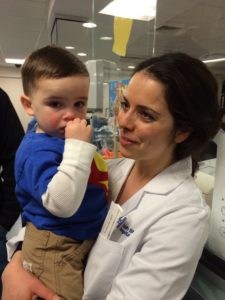By the time Cameron Shearing arrived at the South Shore Hospital Emergency Department (ED) during a December snowstorm, he wasn’t breathing. He didn’t have much time. The two-year-old had aspirated a chocolate-covered pretzel, which sent tiny bits of material into his lungs.
The odds of a good outcome were not high. Pretzel is one of the worst foods to aspirate for two reasons: The small pieces can block multiple small airways, and the salt, which is very irritating, causes a lot of inflammation.
“Cameron was one of the sickest patients I ever cared for as an emergency physician. I did everything I could within my scope of practice, but he needed the tools and expertise of pediatric subspecialists,” recalls Galina Lipton, MD, from Boston Children’s Department of Emergency Medicine, who was staffing the South Shore Hospital emergency room that evening.
Lipton worked on Cameron for an hour, staying at his side as she stabilized him by securing his airway and inserting a breathing tube. She was aware, though, that this hurdle was just the first step in Cameron’s treatment. The delicate job of removing the pretzel bits from his airways would fall to a pediatric surgeon or cardiothoracic surgeon with a specialized bronchoscope. All were available at Boston Children’s.
On most days, Cameron would have been transported to Boston Children’s after the emergency team stabilized him. But Cameron had two strikes against him, says Lipton.
Unlike a straightforward choking case, the pretzel had broken into small pieces and obstructed his airways in multiple locations, making it very challenging to manage his airways. “His entire cardiorespiratory system was at risk of collapse.” The snowstorm exacerbated the challenge, because Boston Children’s Pediatric Critical Transport Team would not arrive for two to three hours. The South Shore Hospital team, which included Boston Children’s physicians and South Shore staff, would have to manage Cameron’s ventilation for a few hours.
Lipton used the TeleConnect real-time video-conferencing telemedicine service to contact Boston Children’s and consult with Melody Duvall, MD, PhD, from Boston Children’s Hospital’s Department of Critical Care Medicine.
The art and science of pediatric intubation
Duvall and Lipton video-conferenced, discussing how to fine-tune Cameron’s ventilator settings, in order to optimize gas exchange in the lungs while taking care not to overinflate his lungs to prevent a pneumothorax as they prepped him for transport.
“The tricky part about aspiration is that it is very difficult to ventilate the patient adequately because the air goes only to the unobstructed parts of the lung. The obstructed part of the lung can collapse, while the unobstructed parts can hyper-inflate and lead to pneumothorax [collapsed lung],” explains Duvall.
“It was almost like having her in the room with us. She could see the monitors, review changes in his condition and consult with all of the providers in the room. [Unlike a phone conference], I did not need to act as a middle man and relay information to other members of the treatment team,” says Lipton. Meanwhile, Duvall began assembling the group of physicians who would treat Cameron on arrival at Boston Children’s.
Cameron responded as the doctors expected. One lung collapsed, while the other over-expanded, pushing the South Shore Hospital team to the highest level of emergency medicine practice. “He was in very serious condition with little reserve,” recalls Duvall.
By 8:00 p.m., nearly three hours after Cameron arrived at South Shore Hospital, the medical transport crew arrived and Cameron was on his way to Boston Children’s.
“When we got off the elevator, there were 40 people waiting for him,” says Nicole Shearing, Cameron’s mother. That crew included a general surgery team, intensive care unit (ICU) staff, respiratory therapy, an extracorporeal membrane oxygenation (ECMO) specialist and support clinicians.
The initial plan was to fish the pretzel out of Cameron’s lung via rigid bronchoscopy, but his unobstructed lung was very overextended and at risk for pneumothorax. His oxygen saturation level, which should be at or near 100 percent, had remained in the 70s for about three hours. He wasn’t stable enough for the procedure.
ECMO, which would bypass Cameron’s heart and lungs to remove the excess carbon dioxide from the lungs and provide oxygen to the body, was the only option to save his life and provide surgeons the time to extract the pretzel particles from his lungs.
Cameron remained intubated on ECMO in the ICU for a few days.
“His doctors prepared us for the worst. They told us he might not wake up, he may not walk or talk,” says Nicole.
Instead, the toddler was weaned from ECMO and woke up a few days later speaking in clear, complete sentences without any apparent neurological deficits. He was weaned from the ventilator, treated with antibiotics and inhaled steroids and released from the hospital in time to celebrate Christmas with his family.
“This case is a testament to technology and to teamwork in crisis—from Cameron’s parents to the South Shore emergency department team to the pediatric critical care transport team to the intensive care team and surgeons,” says Duvall.
Boston Children’s physicians work with emergency physicians and nurses at many community hospitals in eastern Massachusetts. Click here to find us.








